Where does Glider Aerobatics come from?
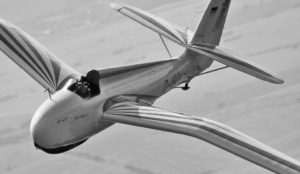 Although loops and spins had been flown with gliders earlier, the history of "real" glider aerobatics began in 1936, when during the Berlin Olympics, aerobatic displays were shown with a glider specifically designed for this purpose. The "Habicht" (Hawk) was the first fully aerobatic glider, capable of performing the majority of aerobatic manoeuvres which previously had been the domain of aerobatic aeroplanes.
Although loops and spins had been flown with gliders earlier, the history of "real" glider aerobatics began in 1936, when during the Berlin Olympics, aerobatic displays were shown with a glider specifically designed for this purpose. The "Habicht" (Hawk) was the first fully aerobatic glider, capable of performing the majority of aerobatic manoeuvres which previously had been the domain of aerobatic aeroplanes.
After WW II the interest in glider aerobatics was revived and, in several European countries, specialised aerobatic gliders were designed. Initially these gliders were flown primarily in air-shows. At a later stage national aero clubs began to organise glider aerobatic contests and national championships. The first official national championship was held in Germany in 1975.
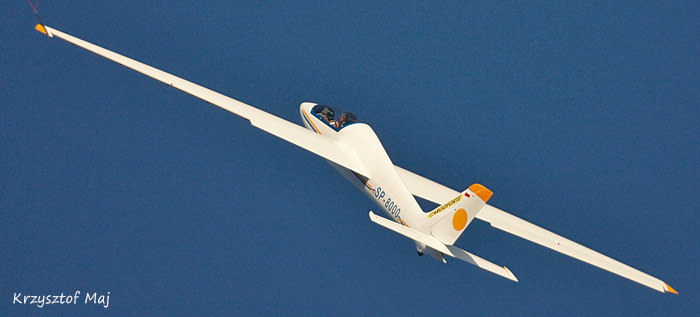 At about the same time Poland, the other major gliding nation in Europe, had started to organise national glider aerobatic championships. In 1982 the Polish Aero Club invited pilots from other European countries to the first international glider aerobatic contest. The first European Championship took place in Germany in 1984 and in the following year Austria hosted the first World Glider Aerobatic Championship. World Champion in 1985 was Polish pilot Jerzy Makula, who topped off his astonishing career in 2011 winning his seventh world champion's title.
At about the same time Poland, the other major gliding nation in Europe, had started to organise national glider aerobatic championships. In 1982 the Polish Aero Club invited pilots from other European countries to the first international glider aerobatic contest. The first European Championship took place in Germany in 1984 and in the following year Austria hosted the first World Glider Aerobatic Championship. World Champion in 1985 was Polish pilot Jerzy Makula, who topped off his astonishing career in 2011 winning his seventh world champion's title.
Until 2010 World Championships were held every other year with European Championships in the intervening years. In 2010 European Championships were abandoned and World Championships are now held on a yearly basis. The most important change to international glider aerobatics, however, has been the introduction of the Advanced category with Advanced World Championships held yearly since 2010 alongside the Unlimited Championships. The Advanced category enjoys ever-growing popularity and in 2019 the first female pilot, Patrycja Pacak from Poland, won the overall Advanced World Champion's title - visit the CIVA Results website for these results and many other examples. Holding both championships at the same time and location enables organisers to make the most efficient use of the airfield facilities and the presence of all the judges, jury and other key officials.
How do we run Glider Aerobatic competitions?
A glider aerobatic championship comprises a maximum of six programmes:
- The Free Known, consisting of five Known and five Free figures. Maximum K (the total of the individual figure K-factors) is 230 for UNL and 175 for ADV. Fresh Known figures are selected each year by the CIVA Glider Aerobatic Committee, and details of the current set for each category are available from the Documents page here.
- Four Unknown Compulsories and one Free Unknown, each consisting of seven figures selected by the teams with a total K of 180 to 200 for UNL (150 to 170 ADV) plus one or two linking figures with a combined K of 10. For the Compulsories the Jury selects a sequence; the procedure for the Free Unknown is the same as in power.
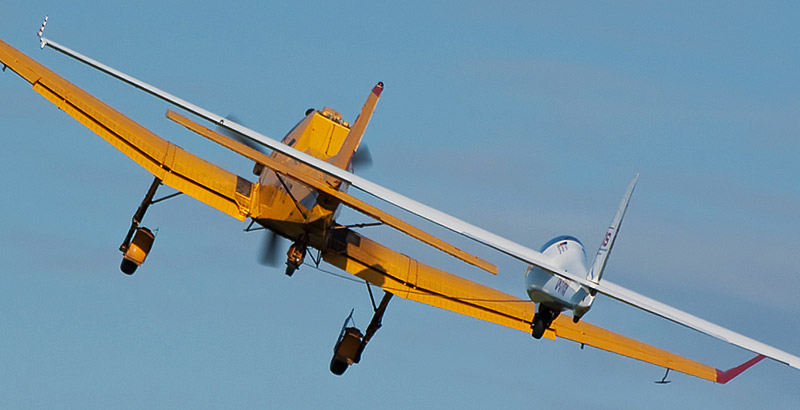 The glider Advanced category differs from Unlimited by the choice of allowed figures. Not flown in Advanced are flicks, rolling turns, negative loops and inverted spins, and no rolls vertically up and no more than ¼ roll vertically down are allowed. Tail-slides are also flown in glider Advanced contests, as at Unlimited and of course in power.
The glider Advanced category differs from Unlimited by the choice of allowed figures. Not flown in Advanced are flicks, rolling turns, negative loops and inverted spins, and no rolls vertically up and no more than ¼ roll vertically down are allowed. Tail-slides are also flown in glider Advanced contests, as at Unlimited and of course in power.
In the glider version of the Aresti catalogue, a number of figures are deleted because they are clearly not flyable without an engine. Otherwise the only differences from the power version are higher K-factors for rolls and rolling turns due to the inferior rolling performance of gliders.
Gliders are towed to the top of the performance zone, which is normally 1,200m AGL. The minimum height for aerobatics is 200m AGL; disqualification height is 100m AGL.
At international championships, the height of the glider is continuously monitored by a height measuring device (HMD). The HMD consists of a small box in the glider with a pressure chip and a data-link transmitter linked to a ground station, close to the Chief Judge, recording the data. Since height at the start of the sequence is critical, gliders are released slightly above the top of the box (performance zone) and the HMD signals the moment when the glider sinks through this altitude. The HMD again signals when the glider reaches the minimum height and also the disqualification height. Starting aerobatics above the box is penalised in the same way as flying figures below the bottom of the box.
What makes Glider aerobatics different?
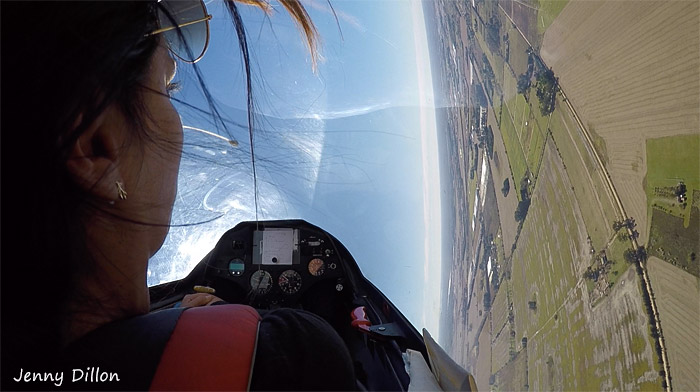 The most obvious difference between gliders and aeroplanes is the lack of an engine. Compared to cross-country gliding, where the gliders use updrafts to stay aloft and cover long distances, an aerobatic glider gets its primary energy in the form of height (potential energy) upon release from the tow-plane. In order to perform aerobatics it trades height for speed (kinetic energy). The performance zone for glider aerobatics is 1,000m between the upper and lower limits. Within this height band the pilot must manage the available energy to fly all the figures in the sequence. When constructing glider sequences, height loss in the various figures is an important consideration.
The most obvious difference between gliders and aeroplanes is the lack of an engine. Compared to cross-country gliding, where the gliders use updrafts to stay aloft and cover long distances, an aerobatic glider gets its primary energy in the form of height (potential energy) upon release from the tow-plane. In order to perform aerobatics it trades height for speed (kinetic energy). The performance zone for glider aerobatics is 1,000m between the upper and lower limits. Within this height band the pilot must manage the available energy to fly all the figures in the sequence. When constructing glider sequences, height loss in the various figures is an important consideration.
Aerobatic gliders obviously must be manoeuvrable, but also must be able to glide. Manoeuvrability and aerodynamic efficiency are to some degree mutually exclusive. The most important aspect of manoeuvrability is a good rate of roll. This can be achieved only with a relatively short wingspan. On the other hand, good gliding performance calls for a slender wing with low induced drag. Aerobatic gliders are consequently a compromise with a moderate wingspan and maximum roll-rates around 90°/sec. Compared to current power aerobatic aeroplane designs this is quite sluggish!
For full aerobatic certification, gliders must have minimum safe load factors of +7 / -5G. Although this is considerably less than for power aerobatic aeroplanes, load-factor limitations are no real handicap in gliders. High-G manoeuvring eats up energy and glider pilots should avoid this if they want to stay within the height limits.
Airspeed limits are more significant for glider aerobatic performance than G-limits. The VNE (velocity never exceed) of most aerobatic gliders is about 280 km/h (150 kts). On the other hand, the high aerodynamic efficiency of modern gliders causes them to pick up speed quickly on a descending flight path. This fact, together with the relatively slow roll-rate, limits the amount of rolling elements on 45° or vertical downlines. At the same time, on vertical or 45° up lines, gliders quickly run out of speed so rolling manoeuvres upwards are also quite limited.
For good gliding performance, practically all aerobatic glider wings have non-symmetric aerofoils, causing significant differences in performance between upright and inverted flight. Inverted gliding performance is much inferior and height loss in inverted manoeuvres is far greater. Also their stalling characteristics differ greatly between upright and inverted flight. Therefore, positive and negative flick rolls look significantly different. In negative flicks most gliders appear sluggish and judges not familiar with this fact will be quick to award PZs (perception zeros) for "no flick".
Judging Glider Aerobatics
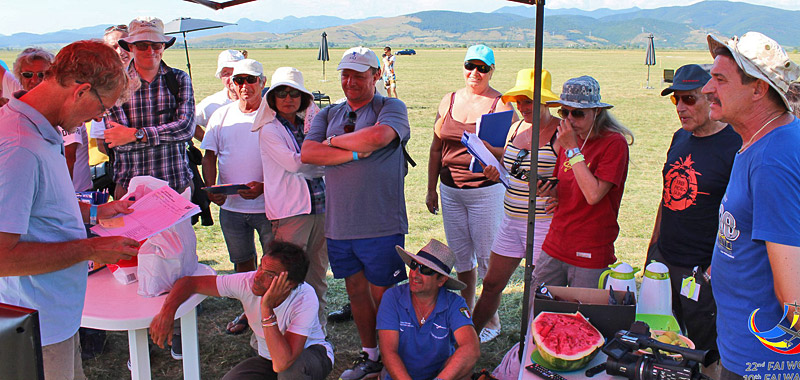 Judging criteria for glider figures are mostly identical to power. There are some differences however, which mainly stem from the fact that gliders cannot fly a horizontal flight path without running out of speed. Thus, a "horizontal" flight path for gliders may be inclined up to ten degrees below the true horizon. Consequently it is not normally possible for a glider to finish a figure at the same height it was entered. The loops in a horizontal figure eight cannot be at the same height, and as gliders may be flicked only within a rather narrow speed-bracket there is no requirement to centre flick rolls on internal lines.
Judging criteria for glider figures are mostly identical to power. There are some differences however, which mainly stem from the fact that gliders cannot fly a horizontal flight path without running out of speed. Thus, a "horizontal" flight path for gliders may be inclined up to ten degrees below the true horizon. Consequently it is not normally possible for a glider to finish a figure at the same height it was entered. The loops in a horizontal figure eight cannot be at the same height, and as gliders may be flicked only within a rather narrow speed-bracket there is no requirement to centre flick rolls on internal lines.
At international championships a minimum of seven judging teams are employed, each comprising a judge and his/her assistant. The judge and assistant must both be thoroughly conversant with CIVA glider judging regulations. Throughout each performance the assistant will 'call' the essential elements of each figure to the judge just before it is executed so the judge can maintain concentration on the glider attitude and flight path, while the assistant's wider view is crucial to spot gross errors that might otherwise not be recognised. The Chief Judge and his assistant manage the panel and review their returned score-sheets, using the official video where necessary to ensure that each figure is correctly assessed. They also monitor the HMD to record any height penalties that must be applied.
Manfred Echter
Typical example of a 2021 Unlimited glider Programme-1 "Free Known" sequence
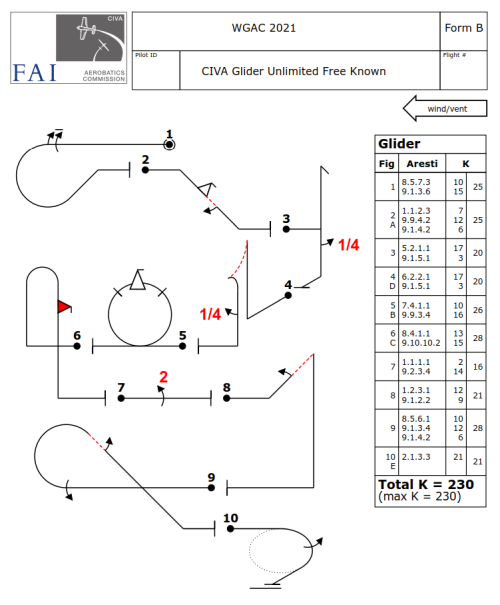
Off-tow at 1,250m, locate to mid-box descending through 1,200m, wing rocks to -
Figure 1
Erect start downwind into 1½ rolls, immediate 5/8 positive loop to plain 45° up-line, push off level. End.
Figure 2
Push into 45° down-line with half positive flick roll then opposite direction half roll, pull level. End.
Figure 3
Pull vertical to stall turn, down-line with centred ¼ roll to pull erect cross-box. End.
Figure 4
Pull vertical to canopy-down tail slide, down-line with centred ¼ roll to pull erect down-wind. End.
Figure 5
Positive loop with full positive flick roll at the top. End.
Figure 6
Pull vertical, up-line to pull-humpty top, down-line with half negative flick roll, pull erect into-wind. End.
Figure 7
Two-point roll. End.
Figure 8
Pull into 45° up-line with half roll to inverted line, pull down to plain vertical line, pull erect down-wind. End.
Figure 9
Full roll into 5/8 positive loop, 45° inverted down-line with centred half roll, pull horizontal into wind. End.
Figure 10
90° rolling turn with one roll outwards to exit cross-box. End, end of sequence.
Wing rocks ... land.
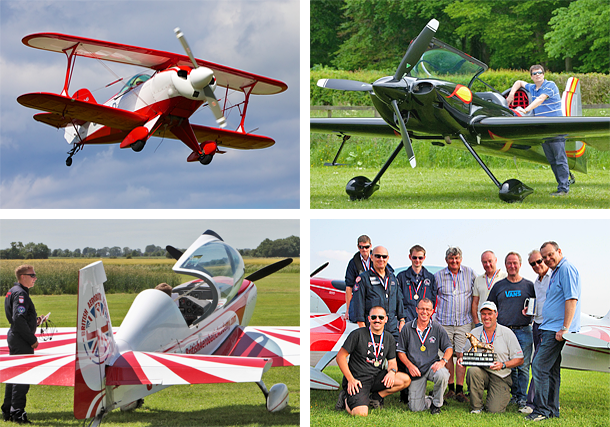
Are you hosting an aerobatic event?
Our aim is to provide forward information for everyone with an interest in aerobatic competition flying.
For this however we do need your help, so please make sure that your Aerobatic Club or National Airsport Control sends us details of all competitions that are open to pilots and/or judges from other countries and we’ll add them to our Championship Calendar so that they get the widest circulation possible.
